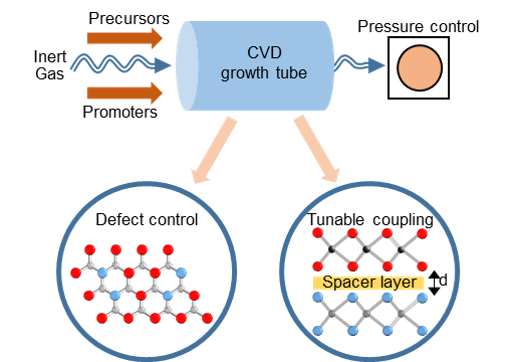Understanding Material Synthesis
Aim: Synthesize non-naturally occurring materials leading to advances in opto-electronics and quantum computing.
Chemical vapour deposition (CVD) is a synthesis process that allows controllable defect control and generation of novel architectures by careful tuning of process parameters. CVD offers a synthetic route towards scalable generation of TMDs, and to modify defect density for optical memory tuning and neuromorphic computing.
Theme 1: CVD growth of homo-phase TMDs and defect control
CVD offers a synthetic route towards scalable generation of TMDs, and to modify defect density for optical memory tuning and neuromorphic computing. Even though CVD has been extensively used to synthesize semiconducting transition metal dichalcogenides (TMDs), the critical importance of choice of precursors as well as growth promoters is poorly understood.
We plan to explore the use of different growth environments (gases; solid or gaseous precursors), as well as after-growth cooling rates to achieve desired opto-electronic properties. To fully advance these materials for commercial applications, an in-depth understanding of the growth environment is critical.
Useful references: Jo et al., “Formation of large-area MoS2 thin films by oxygen-catalyzed sulfurization of Mo thin films”, Journal of Vacuum Science Technology A: Vacuum, Surfaces, and Films, 38, 13405 (2020)
Note about TMDs: Two-dimensional TMDs have unique opto-electronic properties, including enhanced room temperature excitonic luminescence (excitons are Coulomb bound electron-hole pairs), high optical absorption per layer and optical memories spanning large dynamic range.

Theme 2: Synthesis of hetero-phase materials
We also plan to grow hetero and homo-phase bilayers and few layers, which offer enhanced functionality. We will synthesize lateral, vertical and alloy HPMs, which offer different regimes of coupling, band-structure tuning and novel physical phenomena at interfaces.
Useful references: Zhang et al., “Recent Progress in CVD Growth of 2D Transition Metal Dichalcogenides and Related Heterostructures“, Advanced Materials, 31, 1901694 (2019)